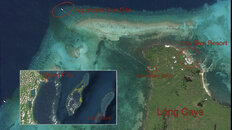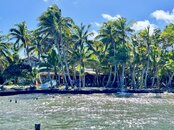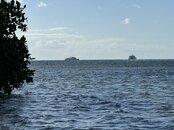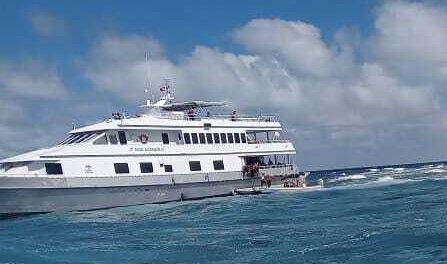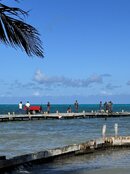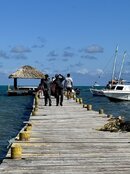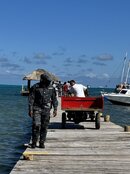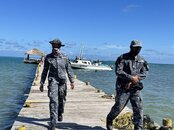Hi, Eric and Lisa (
@Soloist @uncfnp ) Good to see you here!
My wife and I were on the Belize Aggressor IV the week it went aground. I thought I'd chime in with a few points to help fill out the story.
Before that, though...
-- The shark with white spots on its head was known to us as "Patches". The captain told us that when the shark was young, a bird (possibly frigate) grabbed the baby shark in his talons and tried to fly away, but dropped him because of the weight. Evidently, the white patches are bilateral scars that show the pattern of the bird's feet. Or, I'm incredibly naive and like a good story.
-- Bleaching was widespread and heartbreaking. Hitting hard- and soft corals alike, it was everywhere, but quite bad in the shallows. There were many specimens of neon-colored coral, which seems to be their last effort to survive. Captain said they'll all come back; or, I'm incredibly naive, etc., etc.
-- Overall, reef life was disappointingly thin. A few groupers, a lobster, a crab here and there, a ray or two, a solitary turtle, but across all the dives, it seemed that the reefs were nearly deserted. Certainly not the colorful, vibrant environment that we remember from years past (we haven't been out in 5 years.) On occasion we'd run into a decent cloud of chromis, tangs, and the like, but that was infrequent. While I always love to be underwater, the life was a disappointment, and a clear indication of where things are heading.
-- And visibility was poor throughout the week.
As for the boat... just what I recall, with no conjecture:
As has been noted, we were moored in shallow water, shallow enough that the hang bar was not lowered. The captain had scrubbed the previous night's dive due to conditions, and seemed to think that Aquarium would be a good spot to start the next day, with 5 dives planned on a compressed schedule. The first dive of the day was uneventful (see: reef life, above).
At the start of the second dive, conditions were frisky. I'd estimate winds were 8-15 knots, with 2-3' seas.
Susan and I, being a bit bored with the diving, hung out on the wall at 60' and waited to see what would pass by us. We were rewarded with a couple of sharks (inc. Patches) and a very nice spotted eagle ray. Two divers passed under us; Eric & Lisa. At 35:00, we began our swim up the wall and long across the shallows.
Due to my uncanny underwater navigation abilities (read: I got really lucky for a change), we passed right next to the mooring pins. I noted the unusual arrangement of three eyebolts drilled into the rock/coral, with the line passed through all three bolts. I also noted how all the pins were flexing in the rock as the boat and line pulled. "Weird," I thought,"but with three pins it should hold." We swam on toward the boat, and didn't see any other divers along the way.
It couldn't have been more than a few seconds later that Susan heard the mooring line break. (She's spent a lot of time on work boats in the Gulf, and knows that sound.) I was exhaling, so I didn't hear it. Susan got my attention and pointed. We watched the line moving quickly away from us. I seem to recall that there was no hardware on the line, but it did go out of sight very quickly. We signaled to each other, "boat" "broke" "bye-bye".
The captain, who was behind us in the water as divemaster, swam past at high speed, chasing the line. In 43 years of diving, I've honestly never seen anyone swim so fast underwater. He, too, went out of sight very quickly.
Knowing that both we and the boat were adrift, we shot an SMB. Once deployed, we saw that we were already just about done with our safety stop, and made the surface.
Things on the surface were rather chaotic. We tried to group some divers around us and the SMB, but I think that some didn't know what had happened. We told one pair what had happened, but communication on the surface was difficult because we were getting boffed by the wind and waves. Susan and I kept the regs in, BCDs inflated, and swam toward the boat. I couldn't tell at the time if the boat was beached, but it was either make for the boat, or wash up on the shallow reef. Option 1 was the most attractive.
At one point, the crew on the boat was wildly waving us off. "Go back! Stay Away!" We tried to backswim against the wind, waves, and current, but that was almost impossible, as we were getting slammed around by waves. I had the distinct thought, "So, is this how it ends?" Things seemed really dire for more than a few moments.
Not long after, the crew signaled us to make for the boat. (Reminds me of a bad girlfriend. "Stay away!" "Come here!") It was a long swim. Looking down in the water, I saw a trail of destruction. The bottom half of a dive ladder lay on the bottom. Large coral heads were broken and knocked over. The boat was laid up hard on the reef.
Susan made for the port ladder, which was "wobbly". I went for the starboard ladder, which was missing half. Trying to get fins off and high enough on the ladder as the waves were battering the boat was... challenging. We made the dive deck, doffed, and went to muster station 2 as other divers were coming up.
At one point, captain came out and reassured us that we couldn't sink from there. Good point. What about rolling? Fortunately, the boat stayed fairly upright on the reef; it could've been much worse. We were allowed to briefly return to our staterooms to get dry and grab a bug-out bag, which we did with much gusto.
Dominic rescued us off the boat six-at-a-time, putting us on Long Caye. When all divers were ashore, we noticed a hand-painted sign for Wine Bar & Tapas, which was certainly alluring, so we all walked across the island to Itza Resort, utterly surprising the employees there. I mean, imagine the employees hanging out with no guests, and suddenly about 20 people all wearing orange life vests invades your bar? Elvis made sure we were all fed and boozed, and set us up with rooms for the night. Our crap started coming in by fishing boat. Really, not bad for a shipwreck experience. Later, arrangements were made to put us on the Aggressor III, and after their dinner and a five-hour run, we were back in Belize City early, early, early the next day.
I cannot speak to events on the boat, or what measures or considerations were taken leading up to or in the aftermath of the grounding.
Pics: Itza from their dock, and the Aggressor III (left) and IV (not much left.)
Rob



